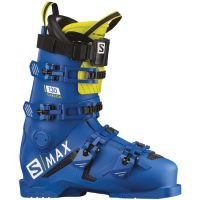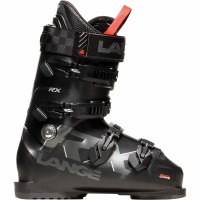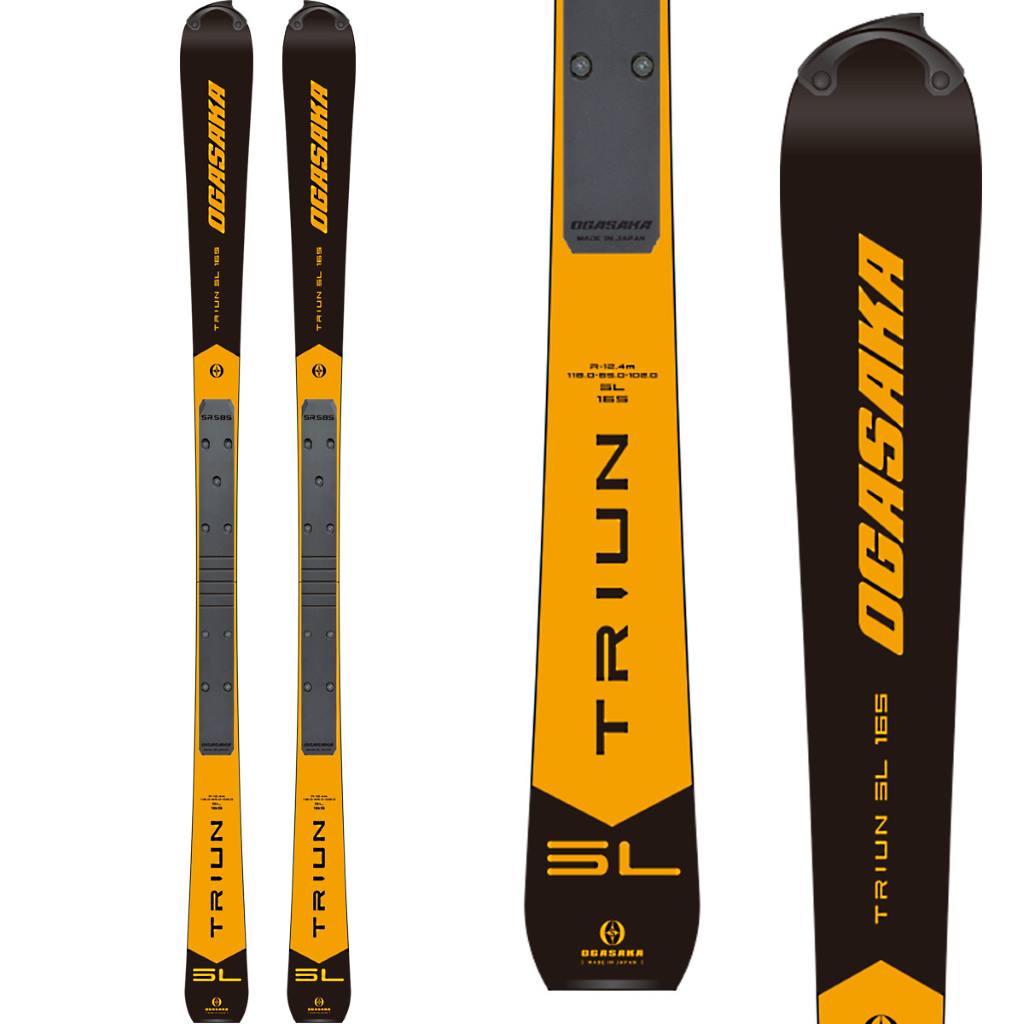118-65-102 r=12.4m @165cm


Manufacturer Info:

Ogasaka Ski Co., Ltd.
653 Kurita, Nagano-shi, Nagano, 380-0921, Japan
Phone +81-26-226-0678
FAX +81-26-228-4857
https://www.ogasaka-ski.co.jp/
U.S. Importer:
Fast Ski Sports
437 Old Mammoth Rd #120
Mammoth Lakes, CA 93546
Phone +1 760-934-4447
https://www.fastskisports.com/
info@fastskisports.com
Suggested Retail Price (MSRP):
$1249.99 usd (with SR585 plate - no binding)
Usage Class:
SL Racing
Rating (with comments):
(1="get me off these things"->10="I have to own a pair")
8-9 For lighter entry-mid level racers or masters looking for a smooth SL
9 For technical carving addicts looking for frontside SL turning tool without olympic-level demand
7-8 For heavier or high-level racers due to slightly underpowered feel under pressure
Background:
Ogasaka ski company started making skis in 1912...so as of 2020, it is a 109 years old and still making skis...perhaps the largest ski company in Japan...so they must be doing something right. Ogasaka is relatively unknown in North America, even if they make a full range of very modern, high-quality racing, technical carving, recreational and junior models (nearly 60 models by a count of their catalog in 2020).
Manufacturer's Description:
"Increased ski stiffness enhanced race performance, maneuverability, and precision under the demanding race condition. Advanced ski tip deflection ensures powerful acceleration and thrust to go fast."
Technical Ski Data:
"NF Wood Core" rumored to be a blend of Chinese paulownia, Japanese wing nut, North American poplar, North Americanm Maple and Japanese beech depending on the model...exact core specs not available. Proprietary core curing techniques are used...some sources indicate cores are dried in a controlled environment for 3 years before assembly. AL7178 (aluminum alloy) sheet(s), Fibre-Reinforced Polymer (F.R.P) & F.R.P (ZTC) (zeolite templated carbon), Rubber Sheet.
Base edge angle = 0.55°, side edge angle = 2.5°
Bindings, Boots & Wax Used:
Tyrolia FreeFlex 14 demo with Ogasaka SR585 11mm riser plate

Salomon S-Max 130 Carbon boots

Lange RX 130 boots

Green Ice Waxes
Pre-Skiing Impression:
Like the other Ogasaka ski models we tested, this pair was stunningly assembled, superbly finished, precisely race-tuned and given a nice base grind pattern and even waxed out of the box. These came premounted with the Ogasaka SR585 riser plate (11 mm) and Tyrolia FreeFlex 14 demo bindings...looking like all-business. Hefty, but not heavy feeling, although it "feels" like a hardwood core carving tool. Rock-solid torsional flex and quietly damp and controlled rebound to hand flexing. Flex is fairly stiff, but nicely balanced demonstrating a rounded arc shape with no hinge points. Lou're not in shape. Race-red topsheet and sidewalls look fast. Nicely textured topsheet looks like it would take nicks and cuts well and age well. These skis gave the impression of high quality craftsmanship and precision rarely found in other brands.
Test Conditions:
Eastern U.S. hardpacked artificial snow, packed powder corduroy, yellow boilerplate, cold granular sugar with death-cookie ice chunks, cold, skied-out early season granular on top of boilerplate.
Summary:
Ogasaka's quality is superb. The fit and finish of the SLs were stunning out of the box. The Triun SL had a stiff hand flex and somewhat "heavy" feel in-hand, but delivered a nicely rounded and more compliant-than-expected pressure response once under way. While lacking the raw power and explosive acceleration of some other SL skis, the Triun SL made up for its slightly lower horsepower with a more friendly engagement and progression through short radius turns making it more accessible to mid and lower-level racers or lighter-weight racers.
Torsional fortitude was progressive and strong, with only the highest pressure levels on gnarly-hard surfaces hinting at any yield or instability in grip underfoot.
Running the SLs flat is non-twitchy, with no grabby feel... easy to set skis on-edge, with a damp and planted feel without feeling dead. The initial tip-and-weight into a trajectory is easy....then need to push it down into "second stage" engagement with surface, where it attaches with predatory bite and authority, but needs dedicated pressure to maintain.
Seriously accurate, precision feel...zero squirrley behavior on smooth, firm surfaces. Superb carving geometry at non-race-pace once set into its sweet spot of flex and edge angle. Turn radius can be varied, although tighening the radius takes deliberate downward effort due to stiffness, but results in confident, controlled, powerful grip in new direction.
The ideal candidate for this ski would be a lightweight to mid-weight entry-to-midlevel (or Masters) racer who would be overwhelmed with the work required of a more intense SL model with a burlier build from other manufacturers. The Triun SL may just fill the void left by many manufacturers between their junior SL models and the hard-core adult models aimed at heavier North American and Northern European national-level racer demographics.
Hardpack and Boilerplate:
The Ogasaka Triun SL is openly civilized about its grip and turn sequence pressure preferences on hardpack surfaces, never requiring an olympian-level effort to get engagement or maintain control during follow-through, yet delivering a high-performance response capable of winning races. You can simply apply some pressure and a bit of angle to the chassis onto the surface and engagement begins predictably and controllably. The Triun SLs seem to prefer a more graduated-pressure, rounded turn shape than an abrupt "J" turn jam-and-pop style, although you can produce the abrupt change of direction by pouncing on them with the desired angle anytime without needing a WorldCup level of fitness and reflex conditioning. Edge feel is superbly accurate and communicative underfoot, so you always know the level of grip and power delivery available during your arcs, with a slightly lower high-end power level than you might find in off-the-shelf SL models from Head, Fischer, Atomic..etc. Edge transitions are quick and controlled, yet never feel squirrely, nervous or premature. The ample vibration damping in the ski's construction and selected riser plate combine to maintain excellent control at all times unless you over-drive the ski in really rugged, ice-rutted surfaces where a bit of waver in edgehold integrity can show through. Overall, the mannerisms and personality on hardpack surfaces are refined and highly performant for the wide range of racers between junior and national level...perhaps ideally targeting the Masters SL enthusiasts in many ways.
Mixed Surface & Variable Conditions:
While and SL race ski is not intended for mixed-surface antics, we did ride the Triun SLs around the resort in a variety of mixed snow conditions and found them super fun, fast and highly sporty when skied a bit flat to avoid the eager directional change of the design on-edge under pressure. The shovel and tail proved quick and enthusiastic in slightly bumpy, mixed condition surfaces, alowing you do dance back and forth with authority and frankly, a bunch of fun when off the race course. Non-race groomer carving was a blast on the Triun SLs, with freshly-blown, styrofoam-squeeky artificial snow being a hoot to carve up on these skis since they can be skied without Herculean effort and concentration.
When you get mixed snow conditions and some surface undulations on the hill, be sure to keep alert. The Triun SL can feel a bit undecided in its trajectory unless you really guide it deliberately at higher speeds. My second run on the Triun SLs surprised me. The quiet, damp manner without twitchy-darty behavior lulled me into false sense of control at speed with a pounce deep into the tails in a somewhat soft-ish surface with random "not-quite-bumps-yet" irregulaties on the slope resulting in a pair of Ogasaka tip logos appearing in my far left peripheral vision up around head-height and a sudden "WHOMP" onto my right shoulder and hip as the skis took a serious height-gaining left turn perpendicular to my line of travel. They spanked me when I got lazy... Pay attention.
Powder Conditions:
Not tested.
Turn Initiation, Apex & Finish:
Turns intiate with a remarkably easy downward pressure and slight edge angulation at nearly any speed. There seems to be a secondary engagement level deeper into the turn past the initial activation of the SLs into an arc, where the real energy builds up to crescendo at the apex, but it's a smooth secondary action... it just feels like there is a stage 1, then stage 2...both predictable and enthusiastic, but distinct. Transition through the apex is smooth and natural, with re-engagement into the next turn coming naturally from the finish of the last. You want to stay centered on the ski for best transitions, although tail-finish enthusiasts will enjoy the energy of the Triun SL at the rear of the bus...just don't stay in the back seat too long. Rounded turn shapes are more natural for the Ogasaka SLs than more harsh, J-shaped turns, but either are available on-demand.
Manufacturer's Mounting Position:
Factory-specified mount with the SR585 plate and FreeFlex 14 bindings was right on the money.
Analogies: ("This ski is like...")
A slightly defanged National-level SL ski available to deliver more approachable performance for a wider audience.
Notable Tester Comments:
Brian Finch and Kerry Finch:
(Kerry is a recent multi-time winner of FIS globes for international masters SL competitions around the World)
"I have to admit this is a quite intimidating ski to take a look at begin with. Initially it was noted to be of incredibly superb construction. The plate which is custom-made in flex cut also appears to be a high-quality and has a very stealthy matte finish. what intimidated me from the get-go was the level of thickness of the ski and the fact that they look to be uniform construction throughout the entire length of the body. Products of this nature tend to be very 2 x 4-ish and difficult to maneuver. bases looked fast and smooth and the tip deflectors looked very low profile and modern.
I was quite surprised when I got on them as they were very supple and even flexing. I mounted them on the suggested center mount. After several misfires at overpressure in the outside ski, I settled on a more 2 foot stance and was able to steer them with ease. Conditions ranged from firm but not quite bullet proof to 4-6 inches of powder.
Overall I felt like this was a very pleasant ski and it had a very round turn shape. I did question how it would perform in the race course as I felt that if I got off line or bubbled, the ski did not pull me through the turn. Once the trails begin to break down in the ice really came out I felt that the ski sort of unravel to a degree. Whereas a more traditional race-stock construction ski would make a more prominent “J” turn and pull you through the latter sections of the direction change, this ski had a very smooth and rounded “C” trajectory. The softer shovel was nice and that it would allow you to close down the turn and jam the outside ski through the fall line a little quicker without skidding out. If the pitch was consistent in the snow was stable, you could make turn after turn of beautiful short to medium mark radius turns with ease. Once the rhythm deteriorated or the conditions became broken down the amount of driver input significantly skyrocketed. A more concentrated deliberate stance and effort was required to work through janky turns and crud. When pressured hard the tail of the ski would quiver.
These struck me as a rather well matched set of boards for a western skier that gets a little bit more softer snow or a Japan-based technical skier. Eastern skiers or racers or for that matter anyone at a eight out of 10 or above level of skiing would probably overpressure the ski. Where this would work very well is for the intermediate racer or master skier who is working on changing turn trajectory and wants to feather the top of the turn without being penalized.
Kerry skied 'em and felt that they lacked some top and power and pop that she was looking for. She also felt that it was really important to set the turn up early and get initial edge angles well above the rise line. Otherwise the ski sort of waffled out. "
Quick Comments:
- Remarkably quiet at high speeds.
- Good feel for surface feedback, even with the 11mm plate.
- Quiet, business-like manner rather than hyper-darty.
- Fairly easy to make mid-course corrections without extreme effort, but rewards a strong hand at the helm to drive the ski properly into its desired trajectory, delivering a nicely-solid grip and tail acceleration on-demand.
- Don't get back on it.
Things I Would Change About This Ski:
Nothing..
Short Answer When Someone Asks "What Do You Think About This Ski?":
Great SL ski for someone who is too heavy for a JR SL model, but not ready to drive a heavyweight, stiff SL full-time.
What kind of skier is this ski good for and not suitable for?
A lighter SL racer or smooth-skiing Masters racer may be an ideal candidate. Heavier, stronger, high-end SL racers at NCAA or National level will overpower the Triun SL.
Advice To People Considering This Ski:
Try to demo other SL models from different companies to judge the personality and demands of each before you decide.
Other Reviews:
None found.
Pics: (click for larger versions)



Ogasaka Triun SL Tip Protector Detail

Ogasaka Triun SL Tip Protector Detail

Ogasaka Triun SL Tip Detail

Ogasaka Triun SL Tail Detail

Ogasaka Triun SL Tail Detail

Ogasaka Triun SL Sidewall Detail

Ogasaka Triun SL Riser Plate Heel Detail

Ogasaka Triun SL Riser Plate Toe Detail



New Graphics for 2021-2022 Season